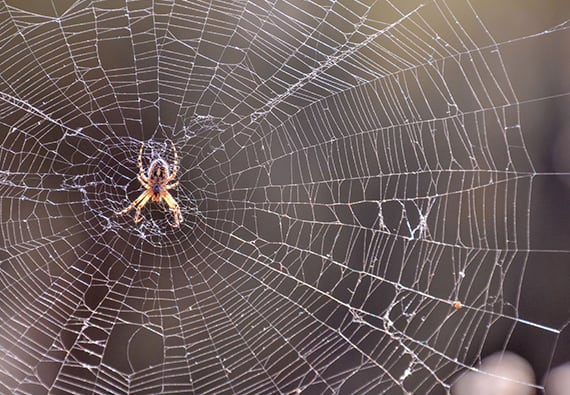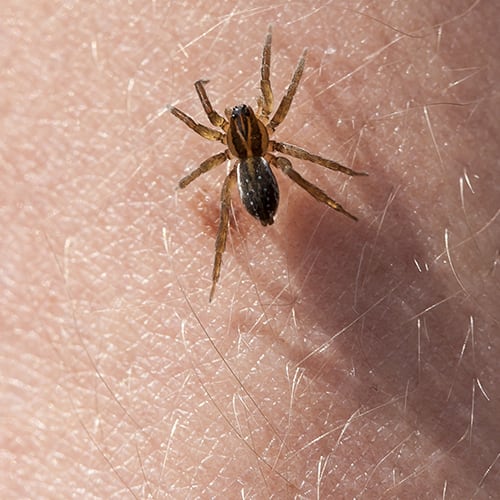A phobia is an irrational, persistent fear of things or situations. The source of the fear can create a strong anxiety reaction such as sweating, heart palpitations, or trouble breathing. After a while, just thinking or seeing the cause of the fear can provoke anxiety. Many people have mild phobias that do not need help, but some phobias interfere with individuals’ daily lives and require treatment. “Arachnophobia” comes from the Greek words arachne, meaning “spider,” and phobos, meaning “a fear.”
Arachnophobia

Trying to get rid of spiders for good?
Get a FREE Quote & BEST PRICE from a local exterminator
(866) 470-1609Available Next Day
No Obligation Assessment
Guarantee Results

When people today hear the word “Arachnophobia,” they think of a preposterous Hollywood movie. But arachnophobia is a very real and serious problem for many people. It can become an obsession, affecting their everyday lives in unimaginable ways. There are historical and cultural reasons for their fear. Treatment methods are evolving from traditional therapies to newer virtual reality simulations.
Greek Myth and Arachnophobia
In Greek mythology, Arachne was a beautiful Greek maiden. She studied weaving under the goddess Athena and had extraordinary skill. When her talents were later recognized, she denied any training Athena had given her. Athena disguised herself into a bitter old lady, approached Arachne, and tricked her into a weaving contest. Arachne wove portraits of the gods performing evil deeds. Athena and Arachne finished their weaving in an extremely short amount of time, but Arachne’s work was much finer than Athena’s.
The goddess was furious that a mere mortal had beaten her in a weaving contest and had portrayed the gods in a disrespectful way. Overcome with rage, she beat Arachne to the ground. Arachne was so upset that she hanged herself. The regretful Athena sprinkled a magic liquid onto Arachne, turning her into a spider so that she could keep her weaving skills.
Historical and Cultural Causes of Arachnophobia
Arachnophobia has historical and cultural causes. According to Graham C. L. Davey of the City University, London, “In most of Europe during the Middle Ages, spiders were considered a source of contamination that absorbed poisons in their environment (e.g. from plants). Any food which had come into contact with a spider was considered infected. Similarly, if a spider fell into water, that water was then held to be poisoned.” (Renner, 1990)
Non-European cultures believe spiders were symbols of good luck or wisdom. But in Europe, they were believed to be messengers of the Black Plague and death.
In fact, most of these diseases were caused by completely different sources than spiders. Spiders were found in great numbers in the same areas of the house as rats. The fleas on these rats were actually the carriers of the plague.
According to Graham C. L. Davey, “Recent studies of spider phobia indicate that fear of spiders is closely associated with the disease-avoidance response of disgust. It is not immediately clear how spiders might have become associated with this response, although examination of the relevant historical literature does indicate a close association between spiders and illness in European cultures from tenth century onward. The development of this association between spiders and illness appears to be closely linked to the many devastating and, at the time, inexplicable epidemics that crossed Europe from the Middle Ages onward. In many areas of Europe, the spider appears to have been a suitable target for the displaced anxieties caused by these constant epidemics; in other cases, its proximity to the real causes of the epidemics may have fostered opportunistic associations between spiders and disease.
“The tendency of Europeans and their descendants to be fearful of spiders does not seem to be shared by people in many non-European cultures…”
“The tendency of Europeans and their descendants to be fearful of spiders does not seem to be shared by people in many non-European cultures, and this is not consistent with those evolutionary accounts of spider fear which suggest that spider fear should be a common feature of the human gene pool regardless of culture (e.g. Seligman, 1971). However, it is consistent with the present thesis which argues that spider fear developed as a result of the association between spiders and disease in Europe after the tenth century.”
In other words, arachnophobia began as misplaced fear during the plague (having historical basis), then was passed down through European families, adding a cultural basis.
Coping Styles of Arachnophobics
Professor Martin Antony of the University of Toronto Psychiatry Department classifies arachnophobics in two categories: “monitors” and “blunters”. When a “monitor” enters a room, he searches the entire room for a spider. When he finds one, he not only makes sure he knows where it is but he continues to follow or monitor it. A “blunter” does the exact opposite: he does everything in his power to keep from seeing a spider in a room. He will distract himself, even talking to himself to avoid seeing the spider.
Traditional Medical Treatment of Arachnophobia
Traditional treatment of arachnophobia is called “systematic desensitization.” Arachnophobes write down the situations with spiders that scare them, then categorizes them from “least frightening” to “most frightening.” They learn relaxation techniques to help deal with these situations. They imagine having to cope with the least frightening situation, and gradually work their way up the list until they are able to cope with the most frightening situation. They then move on to real situations, accompanied by a therapist. They again work their way up from the least threatening to most threatening situation, exposing themselves to real spiders. When arachnophobes are able to hold a live spider without feeling anxious, they have conquered their phobia.
Technology Transforms the Treatment of Arachnophobia
Technology has added a new dimension to treatment of arachnophobia. The University of Washington’s Human Interface Technology Lab and the Norwegian University of Science and Technology, Trondheim are performing studies with virtual reality simulators. Patients wear a VR helmet or glasses and a virtual reality glove. A computer-generated spider moves across the screen, and the patient sees it as a three-dimensional spider. The patient moves the VR glove closer and closer to the spider during the therapy sessions until he or she can “feel” it crawl across his hand. The Norwegian project uses spiders because it is relatively simple to generate a realistic computer image of a spider. The Washington project also uses a small machine toy spider so that patients actually feel resistance to the glove.
One patient in the Washington project, “Miss Muffet,” was so fearful of spiders that she scrubbed her car twice a day. She left a burning cigarette in the car’s ashtray because she believed the smoke would keep spiders away. She examined her room thoroughly every night, duct taped her windows shut, and stuck a towel in the crack under her door before she would go to sleep. After washing her clothes, she immediately ironed them and put them in Ziploc bags to make sure there were no spiders in her clothing. After 12 one-hour sessions in the virtual reality SpiderWorld, “Miss Muffet” conquered her fear and is now able to go backpacking alone.
Exposing phobics to the real source of their fear can be very expensive and sometimes dangerous for the therapist. Using virtual reality, the doctor can control the intensity of the encounter and stop the experience immediately if the patient becomes overwhelmed. Also, reluctant patients can be persuaded into therapy because they are fascinated with the virtual reality helmet, glove, and computer.
Arachnophobia remains a large problem for people of European origin. It has an interesting history in the development of European culture. The advances currently being made in virtual reality treatment may cause arachnophobia to become a thing of the past. If only the movie Arachnophobia could be forgotten as easily!

Trying to get rid of spiders for good?
Get a FREE Quote & BEST PRICE from a local exterminator
(866) 470-1609Available Next Day
No Obligation Assessment
Guarantee Results



